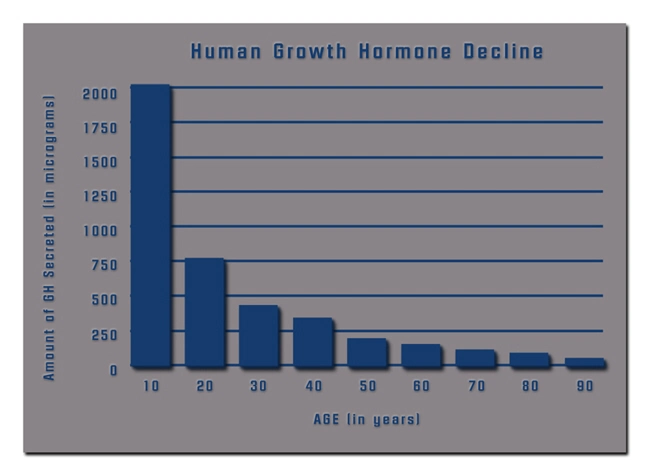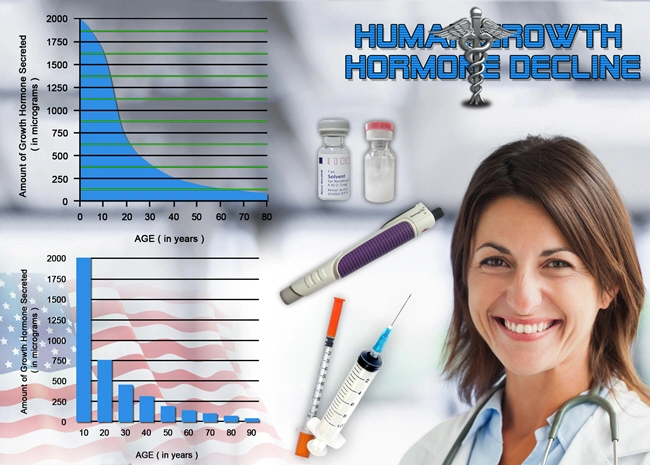
Video Link: https://vimeo.com/281360067
Video Download: Click Here To Download Video
Video Stream: Click Here To Stream Video
The Key Role Your Adrenal Glands Play in Answering That Question
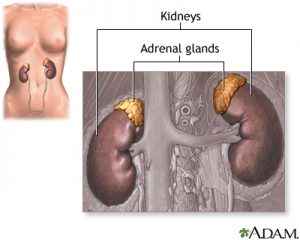
Human Growth Hormone (HGH) Replacement Therapy has many benefits: renewed strength and vigor, relief from joint aches and pains, better sleep, sharper thinking, and stress control, which works wonders for keeping your adrenal glands in tip-top shape.
When most people think about their adrenal glands, the first thing that pops into their minds is the word adrenaline, the “fight-or-flight” hormone that puts us into survival mode in times of danger.
But there is a Lot More to the Adrenal Glands Than Fulfilling That Vital Function
As with most of the body’s functions, balance is required to maintain health.
And the adrenal glands are no different. They perform their job with pinpoint, precise accuracy, and provide us with the hormones we need when we need them, and in the exact amounts, we need for the circumstance.
To understand how vital our adrenal glands are, we will begin by taking a detailed look at the anatomy of the glands, their location, the hormones they secrete, and what could go wrong with the adrenal glands functioning.
Where are the Adrenal Glands Located?
Even though the adrenal glands are a part of the hypothalamic-pituitary-adrenal axis (better known as the HPA axis), they are not bundled tightly to the hypothalamus and pituitary glands.
In fact, they are not located in the brain. They reside just above your kidneys, with one gland sitting on top of one kidney. Obviously, they have a powerful impact on your kidney function.
Most glands and organs that come in pairs are symmetrical. But the adrenals are not.
The left adrenal gland is shaped almost like a half-moon, while the right gland is triangular shaped. They are large compared to most glands, measuring approximately 2.5 inches in length, 3 inches in diameter, and 1 inch in width.
What are the Different Parts of the Adrenal Glands?
There are three distinct sections of the adrenal glands:
The capsule. Similar to the outer layers of the body (fat and skin), the tablet protects each adrenal gland.
The cortex. This is the outer part of the adrenal gland and comprises its most significant portion (approximately 80%). The cortex is divided into three zones: zona glomerulosa, zona fasciculate, and zona reticularis. The cortex is responsible for producing hormones that are essential for life by regulating our blood pressure, controlling our metabolism, and enabling us to respond to stress.
The medulla. This is the inner part of the adrenal gland, located in the middle and surrounded by the cortex. It is approximately 20% of the gland.
What are the Functions of These Three Parts?
The role of the capsule is to protect the glands. That’s it. Vital job, but not too much to elaborate on.
As mentioned, the cortex consists of three separate zones that have three distinct functions.
The zona reticularis is the most buried layer of the gland. Its role is to manufacture hormones such as Dehydroepiandrosterone/dehydroepiandrostenedione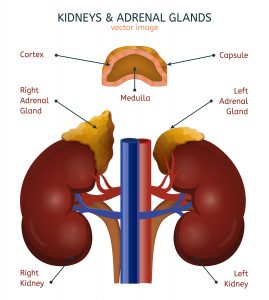 (DHEA) also known as androstenolone.
(DHEA) also known as androstenolone.
The end product can be converted into testosterone, although in men the adrenals play a secondary role in testosterone production compared to the testes.
For women, the adrenals are the primary provider of that male hormone.
The zona fasciculate is located in the middle of the adrenal gland and is in charge of secreting cortisol and its similar compounds.
These hormones are vital since they are responsible for some life-sustaining functions. Cortisol will be discussed in detail later, as it is a many-faceted hormone.
The zona glomerulosa is the part of the cortex responsible for producing mineralocorticoids and excreting fluids and minerals.
The medulla is not as large as the cortex, but it is every bit as necessary: it manages our response to stress.
The medulla secretes three separate catecholamines: epinephrine (adrenaline), norepinephrine, and dopamine.
The definition of catecholamines is any group of chemically-related neurotransmitters, as epinephrine and dopamine, which have similar effects on the sympathetic nervous system.
 As a result of stress, our brain signals the adrenal glands to react quickly by releasing stress hormones, primarily cortisol. These hormones prepare us for battle and danger by withdrawing blood from the skin to the brain and internal organs, make us more alert and slow down our digestive system.
As a result of stress, our brain signals the adrenal glands to react quickly by releasing stress hormones, primarily cortisol. These hormones prepare us for battle and danger by withdrawing blood from the skin to the brain and internal organs, make us more alert and slow down our digestive system.
Also, adrenaline causes our blood sugar levels to spike by converting glycogen to glucose in the liver. Norepinephrine teams up with epinephrine in reacting to stress. It creates the narrowing of blood vessels, a condition known as vasoconstriction. This can cause high blood pressure.
So far, the point has been made that there are goods reasons why most people think of adrenaline (fight-or-flight) and cortisol (stress) when considering the adrenal glands. But these glands do more – much, much more to keep us alive and healthy.
Here’s a look at the many of the body’s internal functions that are controlled by the adrenal glands:
Circadian Rhythm. The adrenal glands release their hormones in cycles known as the circadian rhythm. This cycle is 24 hours with the highest levels secreted in the morning and the fewest levels released in the evening. This is a delicate cycle and if it is disrupted many essential bodily functions are knocked out of whack such as the immune system and energy production.
Fighting fatigue by producing sufficient amounts of energy. This condition relates directly to the circadian rhythm cycle. If this rhythm is not performing precisely, constant fatigue, difficulty getting up in the morning, and mid-afternoon energy crashes are common outcomes. Cortisol is responsible for converting the nutrients we consume (proteins, fats, and carbohydrates) into energy. When the level of cortisol is balanced our bodies process these nutrients efficiently, resulting in a perpetual cycle of high energy.
Keeping our muscles and joints functioning at a high level. The adrenal hormones and the cycles they regulate play an enormous and crucial role in tissue healing. When the glands are underperforming, the lack of tissue repair leads to much more significant problems such as muscle and joint pain which at times can become chronic. This imbalance can also result in weakness in the hip and shoulder girdle muscles.
Strengthening our bones and preventing osteoporosis. The adrenal hormones also play a role in building and strengthening our bones. This is tied to
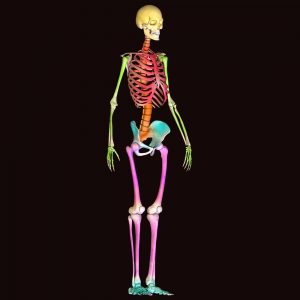 our ability to obtain deep, relaxing, and restorative sleep. If our stress levels are high, so are our cortisol levels. This can interfere with our bone’s ability to obtain the calcium they need. Worse, excess cortisol can weaken the bones by leaching calcium from them, causing a loss of minerals.
our ability to obtain deep, relaxing, and restorative sleep. If our stress levels are high, so are our cortisol levels. This can interfere with our bone’s ability to obtain the calcium they need. Worse, excess cortisol can weaken the bones by leaching calcium from them, causing a loss of minerals.Boosting our immune system. Again, the culprit is high cortisol levels usually as a result of high stress levels. This reduces secretory IgA (SigA) which is known as the mucous membrane surface antibody. This vital substance helps our immune system battle a wide array of problems by blocking bacteria, viruses, plasmids, and toxins. When SigA is not doing its job, we are more prone to afflictions such as sinus infections, bronchitis, sore throat, stomach and duodenal ulcers, gallbladder inflammation, colitis, vaginal, kidney, and bladder infections, and reflux esophagitis.
Low cortisol levels can also wreak havoc on our immune system. The body is in a finely-tuned balance in so many ways, even cortisol levels. Too low levels of cortisol can cause our immune system to become overly aggressive and attack both invaders and beneficial environmental agents in the body.
Allowing us to enjoy the deep, restorative sleep that is so essential to our overall health. Here again, our cortisol levels enter into the picture. If stress is raging out of control, our cortisol levels will also be high. In this state, rapid eye movement (REM) sleep is difficult to attain. REM sleep is the deep, restorative sleep that is so needed to keep our energy levels high the following day. If REM sleep is elusive, the result is fatigue, crankiness, weight gain, and even depression.
Giving our skin the ability to regenerate. Nighttime gives our skin the opportunity to renew. Again, the same simple formula: elevated cortisol = lower skin rejuvenation. The cause is (pardon the pun) more than skin deep. It relates to our levels of zinc and copper. Low zinc and high copper levels are often seen in people with skin problems. The connection is this: excess copper ramps up the transition of dopamine to norepinephrine and adrenaline which leads to excess cortisol. If that weren’t bad enough, low dopamine levels would increase the risk of Parkinson’s and Alzheimer’s disease.
Keeping our thyroid levels correct. The proper functioning of the thyroid gland is critical to our health in many ways, especially preventing weight gain
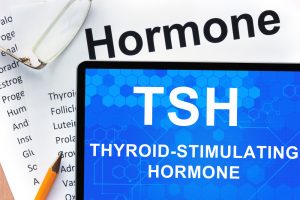 and boosting our energy levels. The thyroid is often referred to as the body’s thermometer, and another analogy is the cleaner in your furnace. If it is under-performing, the condition is called hypothyroidism. The symptoms are increased sensitivity to cold, weight gain, and chronic fatigue. These conditions are directly related to adrenal hormonal imbalances, in particular, high cortisol levels.
and boosting our energy levels. The thyroid is often referred to as the body’s thermometer, and another analogy is the cleaner in your furnace. If it is under-performing, the condition is called hypothyroidism. The symptoms are increased sensitivity to cold, weight gain, and chronic fatigue. These conditions are directly related to adrenal hormonal imbalances, in particular, high cortisol levels.Preventing the loss of libido. As previously mentioned, stress causes cortisol levels to skyrocket. To provide all the extra cortisol needed as a result of this stress the body, in its inherent wisdom, economizes on producing sex hormones to produce more cortisol. In particular, the sex hormone progesterone is practically “cannibalized” as the body’s production shifts to cortisol. Progesterone plays a crucial role in converting testosterone into dihydrotestosterone (DHT). The result? Low testosterone levels, elevated DHT levels, balding, prostate expansion, headaches, and low libido.
The Myth of Cortisol Release and Long Workouts
Here’s another example of why the intricate balance of cortisol levels is so important and misunderstood. Bodybuilders have been preached to, seemingly forever, about the dangers of prolonged workouts.
The consensus seems to be that one hour is about it. Anything beyond that will send your body into a “catabolic” state. Catabolic refers to a process of breaking down muscle, while anabolic is building muscle.
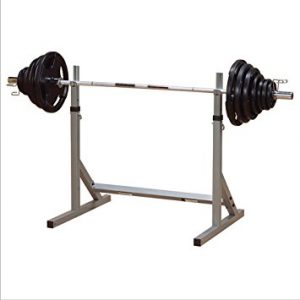 The culprit, we were told, was cortisol. Extended sessions in the gym would over-stress our bodies, and our overworked adrenals would open the floodgates of cortisol. In theory, this makes sense.
The culprit, we were told, was cortisol. Extended sessions in the gym would over-stress our bodies, and our overworked adrenals would open the floodgates of cortisol. In theory, this makes sense.
However, as has been discussed, cortisol is not an easy hormone to understand. It does not respond precisely to an artificially imposed time limit.
A brief, intense 15-minute session of high-intensity interval training can cause an increase in cortisol.
In fact, studies have shown that short, intense sessions produce the most muscle growth AND the most cortisol.
Our muscles need stress to grow. Therefore, workouts lasting longer than 1 hour will not automatically shrink muscles and decrease strength.
The takeaway is this: our hormones work together as a team.
And cortisol is a vital player on that team. Too much cortisol may not always be bad. Conversely, too little cortisol may not always be right. To repeat, it is vital to keep our cortisol levels in proper balance.
What Could Go Wrong With My Adrenal Glands?
There is no single cause of adrenal gland problems. Trouble could arise from within the gland itself or from another gland.
Remember, the endocrine system is a series of intricate relationships, and one gland can at times affect another.
Here are a few common disorders of the adrenal glands:
Addison’s disease. This is an auto-immune disease when the body’s immune system goes haywire and attacks the adrenal glands. The result is that the adrenal cortex doesn’t produce sufficient amounts of cortisol and aldosterone. This can occur at any time to anyone regardless of age.
Adrenal cancer. Fortunately, this is a very rare affliction. There is some uncertainty as to the cause of adrenal cancer. What is known is that many of the same reasons that cause cancer in general also apply to adrenal disease: age, family history, and smoking.
Cushing’s syndrome. This is also a rare condition that is the opposite of Addison’s disease. Instead of producing too little cortisol, Cushing’s disease results in the adrenal’s producing too much cortisol. The are several different causes of this disorder which will be covered in detail below.
Congenital adrenal hyperplasia. This is a genetic condition characterized by low levels of cortisol. As a result, many who suffer from this affliction to have other hormone problems such as low levels of aldosterone (which maintains a balance between salt and water.
Other causes can be tuberculosis, bleeding directly into the adrenals, and other infections of the glands.
The Causes, Testing, and Treatment for Cushing’s Syndrome
Cushing’s Syndrome is named after a physician, Dr. Harvey Cushing.
In 1932, Dr. Cushing observed eight patients with the following symptoms: obesity, emotional instability, menstrual irregularities, excessive hair growth, hypertension, osteoporosis, glucose intolerance, and kidney stones. These are the traits that characterize Cushing’s syndrome.
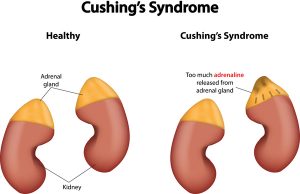 The cause is the excess manufacture of cortisol by the adrenal glands.
The cause is the excess manufacture of cortisol by the adrenal glands.
As mentioned earlier, cortisol is powerful – extremely powerful -- and operates in a finely-tuned, delicate balance.
Too much cortisol = problems with many different cells throughout the body.
Like other difficulties with the adrenal glands, Cushing’s Syndrome is most uncommon (10 people in one million).
The pituitary gland controls the production of cortisol in the adrenals.
Therefore problems in the pituitary like a tumor can spill over into the adrenals. Or the adrenals themselves could develop a tumor.
When the pituitary secretes an excessive amount of adrenocorticotropic hormone (ACTH), this can result in the adrenal gland’s pumping out high levels of cortisol.
This kind of Cushing’s Syndrome is called Cushing’s Disease and is diagnosed by measuring hormone production. When this disease is present serum cortisol levels will be raised, and serum ACTH will also be excessive.
When a tumor develops in the adrenals, they react like any other gland in the endocrine system: pushing out excessive amounts of the hormone produced by the gland.
the gland.
Obviously, if the adrenal tumor is made up of cortisol-producing cells, the result is excess cortisol manufacturing.
At this point, the pituitary’s “radar” will sense the abnormally high cortisol levels and cease producing ACTH to try to slow this process back to normal.
Measuring these levels of ACTH is the blueprint physicians use to determine this condition.
On infrequent occasions, excess ACTH originates somewhere other than the pituitary. This is serious since lung cancer can produce ACTH.
To sum up, here is the break down of the causes of Cushing’s Syndrome:
ACTH-Dependent (80%)
Pituitary tumors (60%)
Lung Cancer (5%)
 ACTH-Independent (20%)
ACTH-Independent (20%)
Benign adrenal tumors (adenoma) (25%)
Malignant adrenal tumors (adrenal cell carcinoma) (10%)
The testing for Cushing’s Syndrome begins with measuring the level of cortisol secreted in 24 hours. The test is repeated at least once. A 24-hour free cortisol level higher than 100 micrograms is indicative of Cushing’s Syndrome.
The treatment of Cushing’s Syndrome naturally depends on the cause. If the reason is a pituitary tumor, the tumor is removed either surgically or with radiation therapy.
If the reason resides in a single adrenal gland, this is surgically removed. If the tumor is cancerous, a more significant, more complicated operation follows. If an individual adrenal gland tumor is small and easy to see, it is removed by laparoscopic adrenalectomy (surgical removal of the adrenal gland).
The importance of the adrenal glands should by now be evident. The levels of cortisol must be kept in a delicate balance; not too much or too little. So what can you do to keep your adrenal glands working in good order?
The Causes of Cortisol Imbalance and the Solutions
Skipping meals, especially breakfast. Cortisol levels rise after fasting for approximately 5 hours. The longer we delay refueling, the more cortisol levels keep rising. In fact, if they zoom way too far past the normal range, they may stay elevated all day.
Not getting adequate rejuvenating sleep. The circadian rhythm cycle is there for a reason. If it is in sync, the body will release hormones on schedule. If not, hormone secretion is disrupted with consequences that can be most unpleasant. Make getting adequate amounts of sleep a top priority.
Chronic poor posture with the chin protruding. Poor posture often is overlooked when considering cortisol. But a caveman's posture with the shoulders and hips flexed can mimic the “flight-or-fight” position that causes a massive release of cortisol and catecholamines. If that weren’t bad enough, the “chin forward” posture impedes signals from the spinal cord, causing them to stop in the middle of the brain. This slows our thoughts and reflexes. Also, poor posture prevents the protein from adequately stimulating the brain which will cause the brain cells to shrink eventually. “Use-it-or-lose-it” is as vital to the brain as it is to the body. Remember mom’s advice: stand up straight!
Pain – both physical and mental. Cortisol can protect us from suffering. But if left unchecked it can spiral out of control and do far more harm than good.
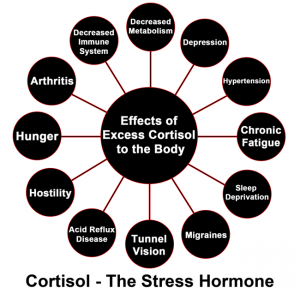 Insomnia, weight gain, muscle weakness, fatigue, and infections are signs of adrenal burnout. Don’t ignore chronic, intense pain. Deal with it.
Insomnia, weight gain, muscle weakness, fatigue, and infections are signs of adrenal burnout. Don’t ignore chronic, intense pain. Deal with it.Constant stress is not handled correctly. Excess, chronic stress can be deadly if not addressed appropriately. Cortisol's primary purpose is to help you manage extreme stress. It pours out in massive doses during the “fight-or-flight” response, as well as starvation and other severely stressful situation. Why does the body release this much cortisol? The answer goes back to our far-flung caveman ancestors. They often needed to swing into action immediately to get lunch or avoid being lunch. Naturally, this resulted in a floodgate of cortisol release. However, those situations were usually over quickly. Our bodies are not designed to deal with the continual cortisol bombardment caused by traffic jams, office politics, demanding spouses, etc. This is why we need to keep our cortisol levels under control. Meditation, exercise, socializing, hobbies – there are many ways to combat and manage stress. Make sure you find the right path for yourself.
High Cortisol Now = Low Cortisol Later
This seeming paradox has a logical explanation. Constant stress and “burning the candle at both ends” robs the body of another vital hormone: pregnenolone, the so-called “mother of all hormones.”
Here’s why. When the adrenal glands are forced to pump out large amounts of cortisol continually, the body is compelled to go after the supply of pregnenolone to make more cortisol.
This stops pregnenolone from making other healthy hormones such as DHEA, estrogen, and testosterone.
Eventually, this vicious cycle takes its toll, resulting in burn-out and low cortisol levels. As mentioned repeatedly, low cortisol is as problematic as excess cortisol.
The Good News
 It is not incredibly challenging to maintain healthy levels of cortisol. The solutions to the problem are mentioned in the above section that lists the issues of cortisol imbalance.
It is not incredibly challenging to maintain healthy levels of cortisol. The solutions to the problem are mentioned in the above section that lists the issues of cortisol imbalance.
The cortisol imbalance plays a crucial role in slowing down and even at times halting the aging process. High or low levels of cortisol are guaranteed to ravage the body both internally and externally.
And never forget the role of adequate growth hormone in countering stress!
If you are concerned about the debilitating effects of aging, follow the simple, common-sense solutions listed above, and turn back the hands of time!
References
An Overview of the Adrenal Glands
Contact Us Today For A Free Consultation
Dear Patient,
Once you have completing the above contact form, for security purposes and confirmation, please confirm your information by calling us.
Please call now: 1-800-380-5339.
Welcoming You To Our Clinic, Professor Tom Henderson.

- A Major Breakthrough in Anti-Aging Science is now Reality! [Last Updated On: October 12th, 2024] [Originally Added On: September 19th, 2020]
- All the Different Brands of Human Growth Hormone -- Guide [Last Updated On: February 10th, 2025] [Originally Added On: September 21st, 2020]
- Weight Loss Through HGH [Last Updated On: February 10th, 2025] [Originally Added On: September 24th, 2020]
- Did You Know: Sarcopenia is Increasing Among Senior Citizens at a Blistering Pace? [Last Updated On: February 8th, 2025] [Originally Added On: October 5th, 2020]
- Growth Hormone and Sleep [Last Updated On: February 9th, 2025] [Originally Added On: October 8th, 2020]
- Hormone Replacement Therapy Program Protocol Diary [Last Updated On: October 11th, 2024] [Originally Added On: October 9th, 2020]
- The Curse of Non-Alcoholic Fatty Liver Disease [Last Updated On: February 6th, 2025] [Originally Added On: October 11th, 2020]
- How Can I Get More HGH (Human Growth Hormone) Naturally? [Last Updated On: July 27th, 2024] [Originally Added On: August 16th, 2021]
- Cholesterol and Growth Hormone...the Truth May Surprise You! [Last Updated On: February 5th, 2025] [Originally Added On: October 7th, 2021]
- Growth Hormone FAQ's [Last Updated On: February 4th, 2025] [Originally Added On: October 8th, 2021]
- Growth Hormone: A powerful tool to battle Erectile Dysfunction [Last Updated On: February 6th, 2025] [Originally Added On: October 8th, 2021]
- How to buy Growth Hormone [Last Updated On: February 7th, 2025] [Originally Added On: October 8th, 2021]
- Testosterone Battles Diabetes [Last Updated On: February 3rd, 2025] [Originally Added On: October 8th, 2021]
- Buy Growth Hormone! [Last Updated On: February 9th, 2025] [Originally Added On: October 8th, 2021]
- Growth Hormone reduces Heartburn [Last Updated On: February 5th, 2025] [Originally Added On: October 8th, 2021]
- The Link Between Diabetes and Growth Hormone [Last Updated On: February 7th, 2025] [Originally Added On: October 8th, 2021]
- Growth Hormone and Nutraceuticals [Last Updated On: February 8th, 2025] [Originally Added On: October 8th, 2021]
- Growth Hormone and Depression [Last Updated On: February 3rd, 2025] [Originally Added On: October 11th, 2021]
- Growth Hormone and the Pituitary Gland [Last Updated On: February 1st, 2025] [Originally Added On: October 11th, 2021]
- Growth Hormone and Calorie Restriction. [Last Updated On: February 2nd, 2025] [Originally Added On: October 11th, 2021]
- Growth Hormone and Healthy Living Can Add Years to Your Life! [Last Updated On: February 2nd, 2025] [Originally Added On: October 11th, 2021]
- Welcome to Growth Hormone and Testosterone Therapy [Last Updated On: December 27th, 2024] [Originally Added On: October 11th, 2021]
- Human Growth Hormone Medical Guide [Last Updated On: June 9th, 2024] [Originally Added On: October 25th, 2021]
- HGH Female Blood Panel [Last Updated On: July 9th, 2022] [Originally Added On: October 28th, 2021]

